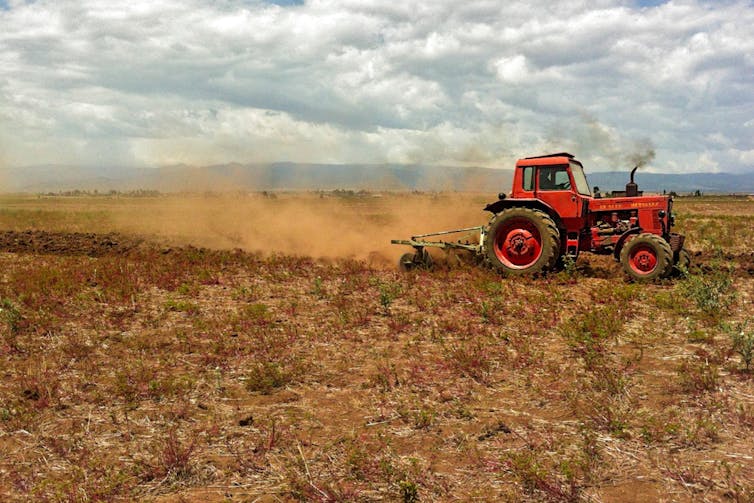Because of its growing impact on society, global warming has taken centre stage in the public debate. While most of us have not read the reports by the Intergovernmental Panel on Climate Change (IPCC), heat waves, intensifying storms and the multiplication of extreme events remind us of the scale of climate disruption and the urgency of action.
Despite being documented by the Intergovernmental Sciences Policy Platform on Biodiversity and Ecosystem Services (IPBES), the equivalent of the IPCC for biodiversity, we know little about how biodiversity erosion might affect us and the rest of the planet. Its links and interactions with climate change are underestimated, and any policy to address either in isolation will miss the mark. It’s impossible to take effective action against global warming without addressing our impact on the rest of the living world, and vice versa.
Fossil carbon, living carbon
IPCC scientists have been explaining since their first assessment report (1990) that climate change is a stock problem. To halt global warming, it is not enough to slash greenhouse gas emissions. We need to stabilise their stock in the atmosphere. To achieve reach net zero we must reduce emissions – the inflow into the stock – to the level of the outflow, which is made up of CO2 absorption by carbon sinks (forests and oceans) and the elimination of non-CO2 greenhouse gases at the end of their life cycle.
This requires that we adopt a two-pronged plan, aimed both at cutting down our reliance on both fossil and living carbon. The former feeds the vast majority of the world’s pollution, with coal, oil and natural gas accounting for 70% of the world’s greenhouse gas emissions. Tackling it will require that we take on the so-called energy transition.
On the other hand, a quarter of greenhouse gas emissions come from “living carbon”, mainly as a result of specific agricultural emissions (unrelated to fossil fuel use) and tropical deforestation and other land use changes that erode carbon sinks. There is no way to achieve carbon neutrality without a profound transformation in the use of living resources, to ensure the reflux of agricultural emissions and better protection of carbon sinks. This is the challenge of what we might call the agroclimatic transition.
One of the major difficulties of the ecological transition is to carry out these two transformations simultaneously, as they involve distinct economic mechanisms. For fossil carbon, we need to introduce scarcity by reducing the use of coal, oil and natural gas to the absolute minimum. For living carbon, we need to reinvest in the diversity of ecosystems to reduce agricultural emissions and protect carbon sinks as part of a bioeconomy.
From adding to subtracting
Since the start of the Industrial Revolution, energy transitions have followed one another. They have all involved adding new energy sources to a system initially based on the use of biomass. The result has been a massive increase in the amount of energy used worldwide.
The climate is forcing us to break with this logic. Lowering emissions is not a matter of adding decarbonised sources to the energy system. It’s about removing fossil fuels. We need to switch from a logic of addition to one of subtraction.
Ifpri/Flickr, CC BY-SA
From an economic viewpoint, this means massively reconverting brown assets linked to the production or use of fossil fuels, through a double movement of investment in green and disinvestment in brown. The heaviest cost for the economic system is not the hundreds of billions invested in wind or solar farms, battery gigafactories or hydrogen electrolysers. It’s the cost of disinvestment that forces us to downgrade or reconvert brown assets: financial assets, of course, but also physical assets and, above all, the human assets on which the energy transition depends.
Multiple instruments will have to be called upon to bring about such a transformation. Pricing carbon from fossil fuel use is a key way to reflect the increasing scarcity of the atmospheric capacity to store carbon. Whether obtained through taxation or emission trading schemes, such taxation raises the cost of using fossil fuels, without returning the resulting rents to producers, as happens, for example, when oil prices soar on energy markets. On the demand side, it is a powerful stimulus to energy efficiency and sufficiency; on the supply side, it encourages a shift away from carbon assets.
The main difficulty with fossil carbon taxation lies in controlling its distributive impact. As the “gilets jaunes” protests in France showed, fossil carbon taxation without redistribution to the most vulnerable poses more problems than it solves. Only a redistributive carbon tax will be socially acceptable. Similarly, if carbon pricing is to be extended on an international scale, the proceeds must be returned on a massive scale to the countries of the South.
The distributional impacts of regulated carbon markets should also not be underestimated. Within the European Union, the extension of the emission trading scheme to the transport and buildings sector will increase household energy bills. This is why the proceeds from allowances sales at auction must be redistributed to the most vulnerable households via a “social fund” which will be the pillar of the regulation to be put in place.

Wikimedia, CC BY-SA
While fossil carbon taxation accelerates the energy transition, negative carbon taxes – in other words, fossil fuel subsidies – delay it. Following the outbreak of war in Ukraine, these subsidies reached unprecedented levels in the European Union, with the multiplication of “tariff shields” erected as a matter of urgency to protect Europeans from the worst of the cost of living crisis.
Another pernicious form of subsidy to fossil fuels is the free allocation of CO2 allowances in the European trading scheme, which hampers the emergence of a green industry, a lever for the competitiveness of tomorrow’s Europe.
Investing in the diversity of living beings
Let’s imagine for a moment that the world has eradicated all use of fossil fuels in 2050. Would we automatically be in a situation of climate neutrality? Everything depends on what has been achieved on the second front of the transition, that of living carbon, the source of a quarter of the world’s greenhouse gas emissions.
Pricing fossil carbon is hardly useful for the agroclimatic transition. Worse, it could even prove counterproductive: using a CO2 price based on energy criteria, it would become profitable to transform the Amazon rainforest (or the centuries-old oaks of the French Tronçay forest) into short rotation coppice to produce energy! The reason is simple. Agro-climatic transformation means finding ways to reinvest in biological diversity, in other words, in the abundance of living things. But the price of CO2 does not reflect the value of this diversity. We therefore need to use other instruments, which are more complex to implement.
On land, forests are the main carbon sink. Their capacity to soak up atmospheric CO2 is weakened by a combination of climatic and anthropogenic factors. In France, for example, the CO2 storage capacity of forests has been divided by three since 2005, mainly due to climatic factors. There is therefore an urgent need to adapt forest management methods in anticipation of the severity of tomorrow’s climates. Worldwide, the main anthropogenic impact on forests is tropical deforestation. Its main cause is the expansion of land for crops and livestock. This is why the key to halting deforestation lies in changing agricultural practices.
The key issues of agriculture and food
The impact of farming systems on the net balance of greenhouse gas emissions is not limited to deforestation. Depending on the techniques used, farming systems may themselves release carbon into the atmosphere (deep ploughing, draining of wet soils, etc.) or, on the contrary, store it in living soils (conservation agriculture, agroforestry, etc.). The former erode biodiversity by specialising farmers according to industrial-type logics. The latter use living diversity to intensify production and regenerate the natural environment.
These agroecological techniques also make it possible to better withstand tougher climatic conditions, while reducing methane and nitrous oxide emissions from agricultural sources. In economic terms, their promotion requires investment in innovation, research and development, the establishment of dedicated farm advisory networks and, above all, incentivisation to reward farmers for the ecosystem services they provide to society. This is not something that happens spontaneously on the market. It requires public intervention and dedicated funding.
As in the case of energy, the agroclimatic transition implies, on the demand side, that we consume smarter and less. The foods we eat have contrasting climate footprints. There can be no successful agroclimatic transition without finding ways to dramatically reduce emissions associated with the most polluting ingredients, including industrially processed foods and animal products, especially those from ruminant breeding. The use of food rations might be one way of achieving this, according to the recommendations of the world’s health authorities.
Remembering the ocean
Last but not least, the agroclimatic transition will have to take into account the management of the oceans and marine biodiversity, which are currently the blind spots of climate policies. Global warming and certain human practices (overfishing, pollutant runoff, etc.) are altering marine biodiversity, a crucial component in the storage of CO2 by the oceans. Protecting the ocean sink is vital to stabilise tomorrow’s climate: it is estimated that the continental biosphere contains four times more carbon than the atmosphere. For the oceans, it’s 47 times.
The authors thank Frank Convery for his insightful review

The Climate Economics Chair of Paris Dauphine-PSL University is organising, in partnership with the Toulouse School of Economics and the National Museum of Natural History, the 24th Global Conference on Environmental Taxation, which will take place from September 6 to 8, 2023 and will have as its theme “Climate & Biodiversity: Tackling global footprints”.
Credit: Source link




